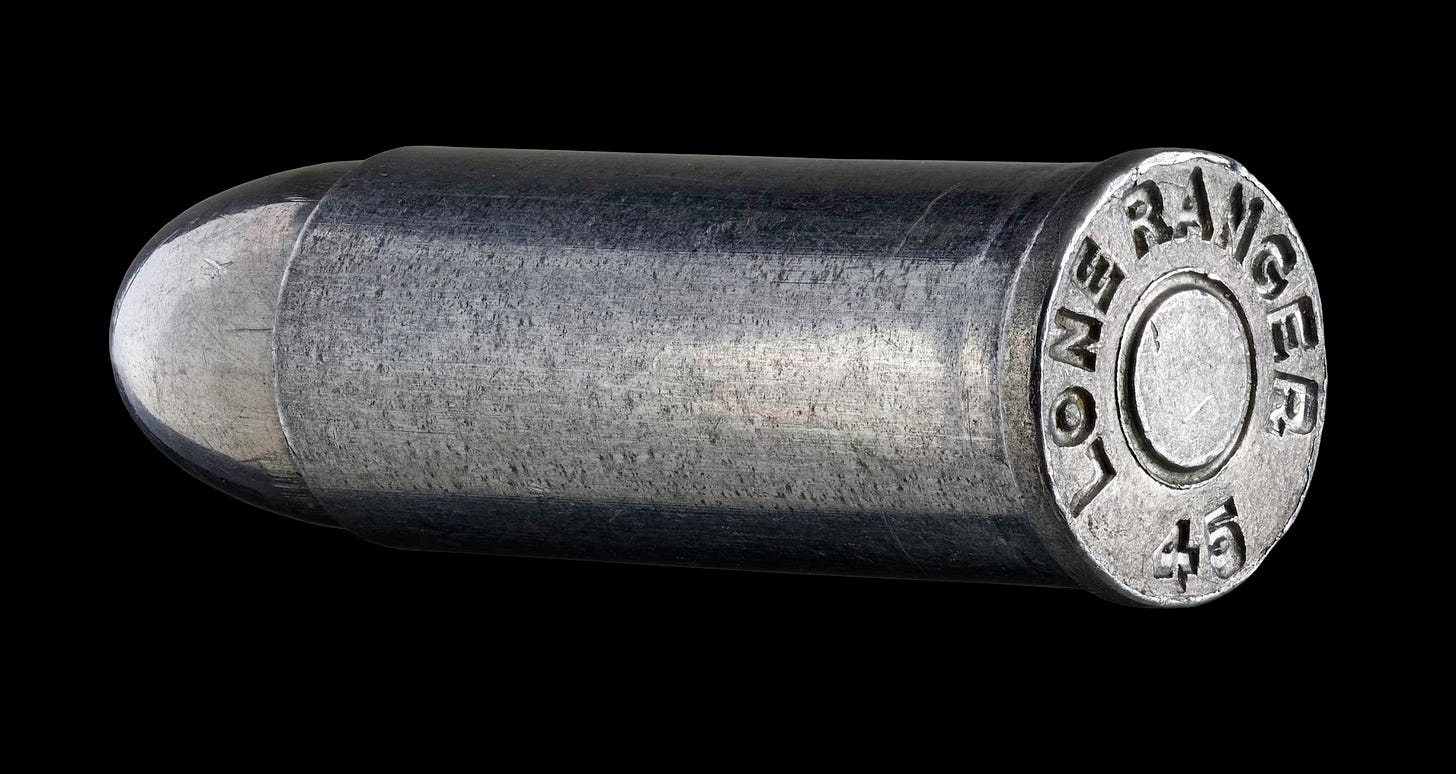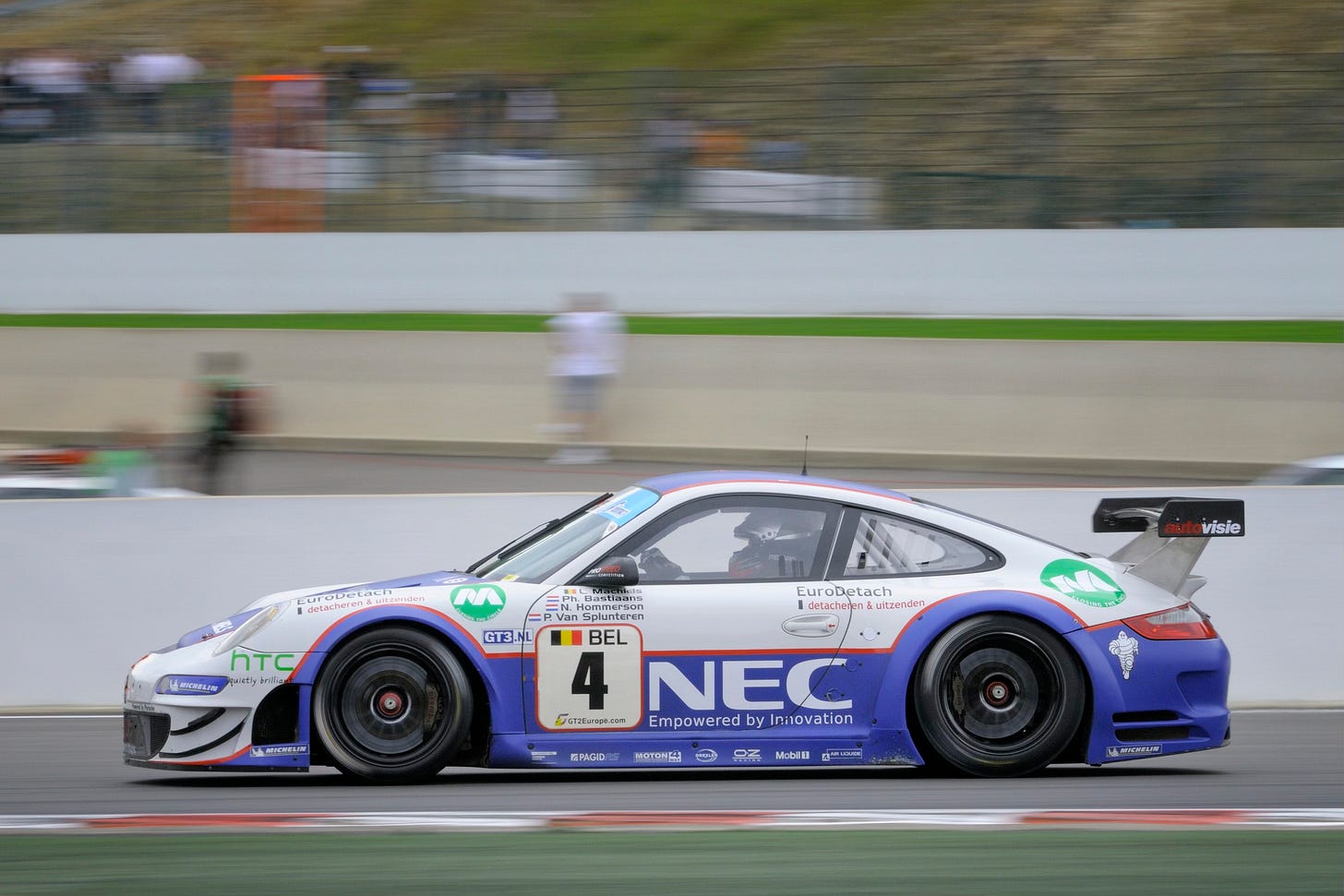“I brake too early, then too late, causing either understeer or oversteer. How do I find the ideal? Gimme the silver bullet!”
I’ve heard this many times, and again recently from a great driver. And I get it, why can’t there be some simple “Do this and everything will be easy” solution to going fast?
Because it would take the challenge, and for sure, the fun out of what we do.
But if there was a silver bullet, what would it look like?
It would be silver-colored, and bullet-shaped!

Seriously, if there were a silver bullet to finding the ideal BoB (Begin of Braking), this would certainly be part of it: Practicing using your vision correctly, using the EoB (End of Braking) as a judgement reference, and developing an understanding of your car’s responsiveness to changing direction.
Note that I didn’t say do each of those perfectly and everything will be perfect. No, what I said was to practice these things, because it’s the process of practicing them that will get you closer to perfection, while trying for perfection rarely leads to progress.
Let’s look at each of these:
Vision: While everyone tells you to “look farther ahead” and “where you want to go” when driving on a track, how you use your vision is not that simple. Nor is it as static as looking farther ahead than you do when driving on the road. As I’ve written here before (Glance & Focus Your Way Around the Track), once you have a moving picture in your mind of where you’re going, then quickly glance almost as far ahead as you can physically see, then scan back to briefly focus on the next major references, then quickly glance ahead, then scan back to the references, then glance, scan back references, and so on… while simultaneously checking your progress (as well as awareness of what’s behind and beside you) with your peripheral vision.
Phew, that’s a lot going on (just visually), right?! Yes, so part of the silver bullet is turning this vision process into a habit, or mental program, to the point where you don’t have to consciously think about it, but it just happens. And yes, it’s putting in the deliberate practice to make firing the silver bullet happen naturally, automatically.
EoB: Thinking about just one corner on a track for a moment, should your BoB be in the same place every lap for it? Probably not. The speed that you’re at when you get to your “usual” BoB will likely change a little from lap to lap, depending on how well you exited the previous corner, other cars that may slow you or give you a draft, the condition of your tires and track (changing grip levels), and even wind direction and strength. So, finding the ideal BoB is a futile, and meaningless target.
I’m not saying that where you begin braking is not important. It is. But judging the initiation of braking off of where you want to be finished is even more important.
When you drive along a highway and a traffic light up ahead turns red, you don’t look for a BoB reference to tell you when to begin to brake. Instead, you judge when to brake by looking at the End of Braking point—in the case of a traffic light, usually the intersection stop line or crosswalk.
When drivers make the switch from having most of the attention on where to brake (most often, a brake reference marker such as a 5, 4, 3, 2, 1 board on the side of the track) to judging where to begin by looking into (and thinking into) where they want to finish braking, they get the start and end of braking (now defining a braking zone) correct, more often. Is it always perfect? No. And that’s why there is always what I call the “Fine-tuning zone” just before the Turn-in, where you either begin to ease off the brakes a little sooner (because it feels as though you’re over-slowing), or you keep pressure on the brake pedal a tiny bit longer (because it feels as though you’re going to enter the corner with too much speed).
(All of this is covered in depth in my Anatomy of a Corner Playbook video)
Where does that judgement of whether it feels as though you’re over-slowing or not slowing enough for a corner come from. Well, experience, for sure. But it’s the quality of the experience that matters most, as we’ll see soon.
Responsiveness: How quickly does your car change direction when you turn the steering wheel to enter a corner? It depends, right? But on what does it depend?
Notice that once you’re in the car, on track, there are only two things you can control: how you turn the steering wheel, and when and how you take your foot off the brake pedal (or modulate the throttle for corners that do not require braking). Mostly, it’s the blending of the steering and brake release that makes the difference. In fact, the silver bullet that many drivers are looking for is right here, with the steering/brake balance and timing. But if you’re not using your vision properly, and judging when to apply and release the brakes by focusing some amount of attention on the EoB, you’ll never get it right.
The final piece of the silver bullet is experimenting… homing in on the ideal.
If you do the same thing over and over again, what are you going to get? You learn more by experimenting that you do by simply getting more seat time, more experience, if that seat time is spent doing the same thing over and over again.

You have to experiment, in a deliberate, thoughtful, planned way. You choose certain sections of the track, or corners, to try different techniques (or the same technique, but with different timing, rates, and/or positions on the track), to experiment. You make changes that are big enough to notice, but not so big that it’s overly risky. I can’t tell you exactly how big the changes should be, but if you take a little time to think about what you’re going to do, you can determine that for yourself.
What’s critical is that you take time before going on track to practice and experiment to play what you’re going to do in your mind. Use mental imagery, or what is usually referred to as visualization, to imagine every detail of what you want to do differently, (and how much differently), because that will greatly increase the likelihood of you doing it the way you want. In fact, every silver bullet is packed with mental rehearsal.
Another way of thinking about the silver bullet is that it’s just one thing: adapting. You adapt your BoB based off of the speed you’re at when approaching the brake zone and corner up ahead. You adapt based on where your EoB is (approximately), knowing that you’re going to use the timing and rate of release of the brakes to either help your car change direction (turn in, rotate, ease in) into the upcoming corner. You adapt in the Fine-tuning zone to whether you’re slowing too much or not enough. You adapt by using your vision properly: mentally, glancing, focusing, peripherally. And then you adapt lap to lap, based on what you learned the previous lap—is the track and tire grip level changing, how did the exit out of the previous corner go, and have other cars made a difference to my speed?
I wish there was a shortcut, but I don’t know of any. And if someone says there is, either introduce me to them, or thank them for their advice and give it a try (but don’t be disappointed if it doesn’t work). I don’t believe there are any shortcuts or magic formulas that work in all situations. If there were, I’d have moved on to another sport, for it’s this blending of many factors, and adapting to them, that makes our sport so challenging and fun.
By the way, this is simply doing the basics better than before. Remember, the advanced super-trick stuff that the very best drivers in the world do is just doing the basics better than everyone else. If there was ever a silver bullet, this would be it.
